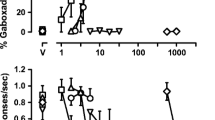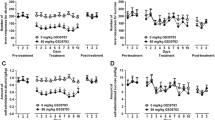Abstract
The behavioral effects of the GABA-related drugs SL 75102 (4-{[(4-chlorophenyl)-(5-fluoro-2-hydroxyphenyl)-methylene]amino}butyric acid) and THIP (4,5,6,7-tetrahydroisoxazolo[5,4-c]pyrindin-3-ol) were studied alone and in combination with lorazepam. Two groups of squirrel monkeys responded under a fixed-interval schedule of food presentation. In one group, responding was suppressed by superimposing a fixed-ratio schedule of response-produced electric shock; responding was not suppressed in the second group. Dose-response curves were determined by administering cumulative doses IV during timeout periods that preceded sequential components of the fixed-interval schedule. Neither SL 75102 (1.0–30.0 mg/kg) nor THIP (0.1–3.0 mg/kg) significantly altered rates of either suppressed or nonsuppressed responding, whereas lorazepam (0.01–0.3 mg/kg) produced dose-related increases in response rate under both schedules. Pretreatment with 1.0 mg/kg SL 75102 significantly enhanced the rate-increasing effects of lorazepam on suppressed responding. Pretreatment with 10.0 mg/kg SL 75102 also enhanced the rate-increasing effects of lorazepam on nonsuppressed responding. In contrast, the rate-increasing effects of lorazepam were not enhanced by pretreatment with 0.3 or 1.0 mg/kg THIP under either schedule. Moreover, pretreatment with 1.0 mg/kg THIP attenuated the rate-increasing effects of lorazepam on nonsuppressed responding. Enhancement of the behavioral effects of lorazepam by SL 75102 may reflect positive allosteric interactions between the two drugs at the benzodiazepine-GABA receptor complex.
Similar content being viewed by others
References
Anderson WR, Simpkins JW, Woodward PA, Winwood D, Stern WC, Boder N (1987) Anxiolytic activity of a brain delivery system for GABA. Psychopharmacology 92:157–163
Barker JL, Mathers DA (1981) GABA analogues activate channels of different duration on cultured mouse spinal neurons. Science 212:358–361
Bovier P, Broekkamp CLE, Lloyd KG (1982) Enhancing GABA transmission reverses the aversive states in rats induced by electrical stimulation of the periaqueductal grey region. Brain Res 248:313–320
Bowery NG, Hill DR, Hudson AL, Price GW (1985) GABA mimetic action of SL 75102 at neuronal receptors. In: Bartholini G, Bossi L, Lloyd KG, Morselli PL (eds) L.E.R.S. Vol 3, Epilepsy and GABA receptor agonists: basic and therapeutic research. Raven Press, New York, pp 63–80
Braestrup C, Nielsen M, Krogsgaard-Larsen P, Falch E (1979) Partial agonists for brain GABA/benzodiazepine receptor complex. Nature 280:331–333
Cananzi AR, Costa E, Guidotti A (1980) Potentiation by intraventricular muscimol of the anticonflict effect of benzodiazepines. Brain Res 196:447–453
Cook L, Sepinwall J (1975) Behavioral analysis of the effects and mechanisms of action of benzodiazepines. In: Costa E, Greengard P (eds) Mechanisms of action of benzodiazepines. Raven Press, New York, pp 1–29
Costa E, Guidotti A (1979) Molecular mechanisms in the receptor action of benzodiazepines. Annu Rev Pharmacol Toxicol 19:531–545
Finney DJ (1978) Statistical method in biological assay. Griffin, London
Goldstein A (1964) Biostatistics: An introductory text. MacMillan, New York
Haefely W, Polc P (1986) Physiology of GABA enhancement by benzodiazepines and barbiturates. In: Olsen RW, Venter JC (eds) Benzodiazepine/GABA receptors and chloride channels: structural and functional properties. Liss, New York, pp 97–133
Herd JA, Morse WH, Kelleher RT, Jones LG (1969) Arterial hypertension in the squirrel monkey during behavioral experiments. Am J Physiol 217:24–29
Hodges HM, Green S (1984) Evidence for the involvement of brain GABA and serotonin systems in the anticonflict effects of chlordiazepoxide in rats. Behav Neural Biol 40:127–154
Hodges H, Baum S, Taylor P, Green S (1986) Behavioral and pharmacological dissociation of chlordiazepoxide effects on discrimination and punished responding. Psychopharmacology 89:155–161
Hoehn-Saric R (1983) Effects of THIP on chronic anxiety. Psychopharmacology 80:338–341
Krogsgaard-Larsen P, Arnt J (1980) Pharmacological studies of interactions between benzodiazepines and GABA receptors. Brain Res Bull 5:867–872
Lloyd KG, Arbilla S, Beaumont K, Briley M, DeMontis G, Scatton B, Langer SZ, Bartholini G (1982) Gamma-aminobutyric acid (GABA) receptor stimulation. II. Specificity of progabide (SL 76002) and SL 75102 for the GABA receptor. J Pharmacol Exp Ther 220:672–677
Lloyd KG, Morselli PL, Depoortere H, Fournier V, Zivkovic B, Scatton B, Broekkamp C, Worms P, Bartholini G (1983) The potential use of GABA agonists in psychiatric disorders: evidence from studies with progabide in animal models and clinical triads. Pharmacol Biochem Behav 18:957–966
Loscher W (1982) Comparative assay of anticonvulsant and toxic potencies of sixteen GABAmimetic drugs. Neuropharmacology 21:803–810
Norusis MJ (1986) SPSS/PC+. SPSS Inc., Chicago
Olsen RW (1982) Drug interactions at the GABA receptor-ionophore complex. Annu Rev Pharmacol Toxicol 23:245–277
Sanger DJ, Joly D, Depoortere H, Zivkovic B, Lloyd KG (1986) Behavioral profile of progabide in tests for anxiolytic and antidepressant drugs. In: Bartholini G, Lloyd KG, Morselli PL (eds) L.E.R.S. Vol 4. GABA and mood disorders: experimental and clinical research. Raven Press, New York, pp 77–84
Sepinwall J, Cook L (1980) Relationship of gamma-aminobutyric acid (GABA) to antianxiety effects of benzodiazepines. Brain Res Bull 5:839–848
Sieghart W, Schuster A (1984) Affinity of various ligands for benzodiazepine receptors in rat cerebellum and hippocampus. Biochem Pharmacol 33:4033–4038
Sokal RR, Rohlf FJ (1981) Biometry. Freeman, San Francisco
Spealman RD, Goldberg SR, Kelleher RT, Goldberg DM, Charlton JP (1977) Some effects of cocaine and two cocaine analogs on schedule-controlled behavior of squirrel monkeys. J Pharmacol Exp Ther 202:500–509
Tallman JF, Thomas JW, Gallager DW (1978) GABAergic modulation of benzodiazepine binding site sensitivity. Nature 274:383–385
Wettstein JG, Spealman RD (1986) Behavioral effects of zopiclone, CL 218,872 and diazepam in squirrel monkeys: antagonism by Ro 15–1788 and CGS 8216. J Pharmacol Exp Ther 238:522–528
Wettstein JG, Spealman RD (1987a) Behavioral effects of the pyrazoloquinoline CGS 9896: agonist and antagonist actions in squirrel monkeys. J Pharmacol Exp Ther 240:82–87
Wettstein JG, Spealman RD (1987b) Behavioral effects of the β-carboline derivatives ZK 93423 and ZK 91296 in squirrel monkeys: comparison with lorazepam and suriclone. J Pharmacol Exp Ther 240:471–475
Winer BJ (1971) Statistical principles in experimental design, 2nd edition. McGraw Hill, New York
Worms P, Depoortere H, Durand A, Morselli DL, Lloyd KG, Bartholini G (1982) Gamma-aminobutyric acid (GABA) receptor stimulation. I. Neuropharmacological profiles of progabide (SL 76002) and SL 75102, with emphasis on their anticonvulsant spectra. J Pharmacol Exp Ther 220:660–671
Zarkovsky AM (1987) Bicuculline-sensitive and insensitive effects of THIP on the binding of [3H]flunitrazepam. Neuropharmacology 26:737–741
Author information
Authors and Affiliations
Rights and permissions
About this article
Cite this article
Wettstein, J.G., Spealman, R.D. GABA-related drugs modulate the behavioral effects of lorazepam. Psychopharmacology 95, 38–42 (1988). https://doi.org/10.1007/BF00212763
Received:
Revised:
Issue Date:
DOI: https://doi.org/10.1007/BF00212763




